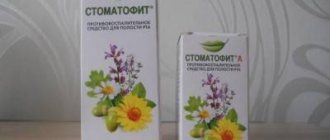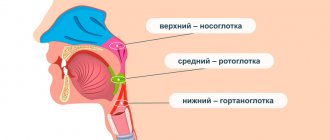Enlarged tonsils in a child may indicate that the body is fighting some kind of infectious carrier, or some other pathologies. With this symptom, it is necessary to treat the underlying pathology in the body.
Author:
- Oganesyan Tigran Sergeevich
ENT pathology expert
4.10 (Votes: 10)
Tonsils (tonsils) are a collection of lymphoepithelial tissue, which is the point of contact of the immune system with the external environment. Thanks to this, the body produces protective immunoglobulin proteins in response to bacteria, viruses, fungi and other foreign microorganisms. Thus, the formation and maturation of immunity occurs. Located at the border of the respiratory and digestive tracts, the tonsils promptly intercept viruses and bacteria that enter the body with inhaled air, water and food.
Enlarged tonsils in a child are not a separate disease. They say:
- that the body is fighting some kind of infectious carrier;
- about genetically determined proliferation of lymphoepithelial tissue without an infectious agent;
- about possible blood diseases (oncohematological diseases), autoimmune diseases and diseases of the endocrine system.
The problem is that tonsil hypertrophy progresses quickly, and it is important not to miss the moment when the painful condition begins to cause severe discomfort to the child, but to treat the underlying pathology in a timely manner. Only an experienced doctor, whose specialization is children's ENT diseases, can correctly determine the true factor in the appearance of the symptom and choose competent therapy to eliminate it.
Mechanism of disease development
Acute laryngitis is an inflammation of the mucous membrane of the larynx. The larynx is located in the front region of the neck. It connects the pharynx to the trachea and performs three vital functions:
- sound-producing (the vocal apparatus is located in it);
- respiratory;
- protective (prevents food and foreign particles from entering the trachea).
Under the influence of a number of factors (hypothermia, overstrain of the vocal cords, allergies, infectious diseases, etc.), the mucous membrane of the child’s larynx becomes inflamed. As a result, a sharp dilation of blood vessels occurs, edema develops, the lumen of the glottis narrows (or completely closes), speech function is impaired and breathing becomes difficult.
Description and symptoms of chronic tonsillitis
Chronic tonsillitis occupies a leading place among inflammatory diseases of the throat. Throat diseases reduce the quality of life and lead to complications. Chronic inflammation of the tonsils is often observed in children starting from 3 years of age and in young people.
Types of tonsillitis
- Acute tonsillitis (tonsillitis) is an infectious disease with local manifestations of acute inflammation of the components of the lymphatic pharyngeal ring, most often the palatine tonsils, which is caused by streptococci or staphylococci, less often by other microorganisms.
- Chronic tonsillitis is a long-term inflammation of the pharyngeal and palatine tonsils. Develops after a sore throat and other infectious diseases accompanied by inflammation of the mucous membrane of the pharynx (scarlet fever, measles, diphtheria), or without a previous acute illness.
There are two stages. Compensated and decompensated stages:
- The compensated stage is a dormant focus of infection. There is no visible reaction from the whole body, no repeated sore throats. The barrier function of the tonsils and the reactivity of the body are not impaired. The edges of the palatine arches thicken, cicatricial adhesions appear between the tonsils, plugs form in the lacunae of the tonsils, liquid purulent discharge forms, and the submandibular and cervical lymph nodes enlarge. One of the problems of the compensated form of tonsillitis is bad breath, which occurs as a result of the formation of plugs in the lacunae.
- During decompensation, frequent sore throats are a concern; complications of tonsillitis in the form of abscesses, inflammatory diseases of the ear and sinuses, as well as damage to other organs (heart, kidneys) are often observed. Exacerbation of chronic tonsillitis is also called tonsillitis.
Symptoms of chronic tonsillitis
- discomfort and pain when swallowing, especially in the morning;
- dryness, sore throat; sensation of a foreign body in the throat
- cough;
- bad breath;
- increased fatigue, weakness and sweating;
- decreased performance;
- low-grade fever 37.2-37.5°C
- deterioration of sleep;
- decreased appetite;
- pain in the cervical lymph nodes.
Causes that can lead to chronic tonsillitis
The following factors have a particularly strong influence on the chronicity of the process:
- Frequent sore throats, especially in the absence of adequate treatment;
- Impaired nasal breathing, which can be a consequence of both a deviated nasal septum and chronic rhinitis and sinusitis. If rhinitis is of an allergic nature, then it is advisable to do an allergen test and undergo appropriate treatment;
- Low body immunity.
Chronic tonsillitis develops due to a number of factors
- Intoxication - due to the absorption of bacterial toxins and products of chronic inflammation in the tonsils. Intoxication explains symptoms of chronic tonsillitis such as fatigue, weakness, headache, low-grade body temperature, etc.
- The formation of plugs in the tonsils irritates the nerve endings and causes moderate pain in the throat and heart area, cough, and bad breath. Nerve endings undergo degenerative changes, which can cause neurosis and other disorders of the nervous system.
- The body develops sensitivity to bacterial and tissue antigens - an allergy develops. Therefore, chronic tonsillitis is also of an autoimmune nature.
Chronic tonsillitis with complications can lead to functional disorders of cardiac activity, acquired heart defects. Chronic tonsillitis is associated with pathologies such as rheumatism, infectious arthritis, diseases of the urinary system, prostate gland, meninges, etc.
Features of the disease in children
Intensive development of the lymphoid ring begins in infancy - in the second year of life. Immediately after birth, the tonsils are underdeveloped and do not yet function fully. A feature of the tonsils in children 1-3 years old is deep lacunae, as well as narrow, densely branching orifices, which can extend to the capsule. Sometimes the lacunae turn sharply and extend under the integumentary epithelium instead of going deep into the tonsils. At the end of narrow passages there are characteristic expansions that contribute to the development of the inflammatory process.
A feature of younger age is hypertrophy of lymphoid tissue, which, along with an increase in the number of lymphoid follicles, leads to the growth of tonsils. The latter reach their largest size by 5-7 years. At this age, children are most susceptible to infectious diseases and most need protection from infections. Representatives of this age category are recommended to receive preventive vaccinations aimed at mobilizing lymphoid tissue to develop immunity.
The cause of hypertrophy of lymphoid tissue is the intensive formation of active immunity, which is accompanied by local production of antibodies in response to the penetration of an infectious agent. With age, by the age of 9-10, antibodies accumulate in the body, the immune system improves, which leads to age-related involution of lymphoid tissue. Part of it degenerates and is replaced by connective or fibrous.
The causes of childhood respiratory diseases are fungi, bacteria and viruses. If a child gets sick too often, the tonsils are regularly attacked, so the body does not have time to fully defend itself. This becomes the main reason for the development of chronic tonsillitis, along with incorrectly prescribed antibiotic treatment.
Chronic tonsillitis in a child turns into a constant source of infection, depleting the immune system. Quite often, the disease leads to serious complications, especially if timely help is not sought.
Symptoms
Unlike adults, in children the disease develops quickly, occurs in an acute form and is quite obvious. An obvious indication of chronic tonsillitis may be the following local reactions:
- redness of the tonsils;
- their increase, looseness;
- purulent discharge;
- enlarged cervical lymph nodes.
Frequent sore throats, bad breath, and discomfort during swallowing may also indicate the chronic nature of tonsillitis. Some patients experience sleep problems, headaches, and a subfertile temperature (37-37.5 °C).
Chronic tonsillitis in a pregnant woman
Symptoms of the disease in a pregnant woman are fever, general weakness, dry cough, sore throat, which is accompanied by a sensation of a foreign body. This is due to the fact that the tonsils withstand the attack of tonsillitis and respond to it with pain.
Not everyone knows that even a mild sore throat can harm the unborn child, as well as the woman herself. Sometimes the disease causes early miscarriage, and sometimes causes the development of late toxicosis, which negatively affects the development of the fetus. Since the presence of a chronic infection in the body weakens the immune system, a pregnant woman is at risk of developing other diseases.
Clinical studies have confirmed that chronic tonsillitis has repeatedly caused poor labor and premature birth, so women with this diagnosis are often recommended to have a cesarean section. Sometimes a disease that is not treated during pregnancy leads to the development of a heart defect in the child.
Causes of chronic tonsillitis in pregnant women
- sore throat, which has become a latent chronic form;
- hypothermia;
- deficiency of vitamins and nutrients;
- weakened immunity;
- problems with nasal breathing caused, for example, by a deviated nasal septum, polyps or adenoids;
- untreated caries;
- sinusitis.
To avoid undesirable developments, pregnant women are advised to eat well, avoid hypothermia, visit the dentist and generally monitor their health.
Why is chronic tonsillitis dangerous?
Regardless of the form of its occurrence, chronic tonsillitis can cause allergization and infection of the body. In the absence of medical control, the disease can lead to serious complications - frequent exacerbations in the form of a sore throat, recurring up to 6 times a year.
Another serious complication is phlegmon of the neck, which occurs against the background of severe forms of peritonsillar abscess. In addition, weakening of the tonsils leads to the penetration of infection into the underlying respiratory tract and the development of pharyngitis and bronchitis. In general, chronic tonsillitis either itself becomes a source of concomitant diseases or complicates their course.
An infection that has entered the body finds “weak” spots and can cause diseases of any of the systems - bronchopulmonary, urinary, cardiovascular. A chronic focus of infection has a negative effect on the blood coagulation system, metabolic and endocrine processes, the adrenal cortex, and the course of allergic conditions. Inflammation of the palatine tonsils causes epileptic attacks and aggravates the course of encephalitis and cerebral rheumatic vasculitis. The most dangerous is the decompensated form, which provokes changes in internal organs.
Consequences of chronic tonsillitis
- The disease in a certain way affects the course of collagen diseases - rheumatism, systemic lupus erythematosus, scleroderma, polyarthritis, dermatomyositis, periarthritis nodosa.
- The cause of frequent sore throats is heart disease - arrhythmias, endocarditis, myocarditis, acquired defects. Since there is a close connection between the lymphatic system of the heart and the ducts of the tonsils, even people under the age of 30 are diagnosed with cardialgia.
- Chronic intoxication has an adverse effect on blood vessels, especially capillaries. Patients complain of increased fatigue, weather sensitivity, headaches including migraines, and dizziness (Meniere's syndrome).
- The consequence of the chronic form of tonsillitis can also be diseases of the gastrointestinal tract - gastritis, colitis, duodenitis, stomach and duodenal ulcers.
- Against the background of chronic tonsillitis, skin pathologies and diseases of the subcutaneous fatty tissue often develop - psoriasis, neurodermatitis, acne, microbial eczema, atopic dermatitis, polymorphic exudative erythema. It makes no sense to treat them until the source of infection is eliminated.
- Chronic tonsillitis often causes lung diseases - bronchial asthma and chronic bronchitis, and also contributes to the exacerbation of chronic pneumonia. According to pulmonologists, the number of complications with such diagnoses can be reduced by 2-3 times if the source of infection is carried out in a timely manner.
- The disease also has a negative effect on the accommodative apparatus of the eye. Early sanitation can, according to ophthalmologists, prevent the development of myopia, as well as prevent relapses of conjunctivitis and blepharitis.
- The liver and the biliary system are also targeted by infection: cholecystitis, cholangitis and cholangiocholecystitis develop against the background of tonsillitis.
- Weakening of the functions of the pancreas due to focal infection in the tonsils contributes to the formation of diabetes mellitus. The thyroid gland also suffers, and its hormone-forming function is disrupted (thyrotoxicosis).
- Against the background of tonsillitis, there are disorders in the reproductive sphere: potency in men decreases, and in women of childbearing age, uterine bleeding, endometriosis, uterine fibroids, hypomenstrual syndrome and infertility are observed. Cases of pathological pregnancy - threats of miscarriage and premature birth - are not uncommon.
- Another serious consequence is kidney damage (pyelonephritis, glomerulonephritis, nephritis, etc.).
Causes of acute laryngitis in children
In order for assistance to a child with acute laryngitis to be as effective as possible, you must first find out what caused the development of the disease. The main provoking factors include:
- ARVI, influenza;
- bacterial respiratory tract infections caused by pneumococcus, staphylococcus, streptococcus, hemophilus influenzae;
- complications after scarlet fever, measles;
- inflammation of the paranasal sinuses;
- local/general hypothermia of the body;
- inhalation of cold, smoky air;
- congenital weakened resistance of the respiratory tract;
- unfavorable environmental conditions;
- contact with allergens;
- uncontrolled use of sprays and aerosols for the throat, leading to a reflex spasm of the larynx in a child;
- overstrain of the vocal cords (strong screaming, loud singing);
- infectious diseases of the oral cavity;
- stress factors.
How to treat a child's sore throat
We are all accustomed to brushing our teeth twice a day, because this is the key to their health. However, isn’t it necessary to take care of the health of the nasopharynx as a whole, because bacteria multiply not only between the teeth, but also on the tongue and in the throat. Loose tonsils are a favorable environment for the growth of bacteria, so keeping them clean is no less important than keeping the mouth clean.
The first rule is rinsing
The child should be taught to gargle as early as possible.
This is not easy, but clean tonsils are the key to strong immunity and its health in the future. There is no need to buy newfangled medications: ready-made commercial sprays or rinses are far from the most effective remedies for a sore throat. The most effective antiseptic is regular table or sea salt . It is saline solutions that are the best:
- moisturize mucous membranes;
- kill bacteria;
- relieve inflammation.
Just pour warm water into a glass, add a teaspoon of salt, a teaspoon of soda and a couple of drops of iodine - this is the best remedy for treating a sore throat. When the throat is inflamed, this recipe can be adjusted by adding one aspirin tablet to the water - this will improve blood flow to the diseased organ.
When a child has a loose, but not red throat, this does not mean that he does not need to be treated and wait until the problem gets worse. Teach your child to gargle after eating. This will prevent food particles from getting into the lacunae of the tonsils and turning into pus.
Solutions and lozenges
The basic rule for choosing lozenges and rinsing solutions: these preparations must be plant-based.
There are a lot of tablets for sore throats in pharmacies. This is exactly what you need to pay special attention to when choosing a medicine. Pain cannot be treated, it is relieved, but it is the sore throat that needs to be treated! Many drugs simply relieve pain and discomfort, but the problem of loose tonsils remains. Doctors recommend paying attention to the composition of medications. If there is a large amount of lidocaine and a minimum of plant extracts (for example, Decathylene, Hexalize, Orasept), such products are not suitable for treating a sore throat. If the composition of the tablets is more natural and natural, this is the best remedy for combating tonsillitis and loose tonsils. Lisobakt, Tonsillotren, Trachisan tablets, rinses and Tantum Verde lozenges performed well.
Symptoms of acute laryngitis
In childhood, acute laryngitis develops quite rapidly. At an early stage of the disease caused by a virus, the child experiences:
- general weakness,
- nasal congestion,
- soreness,
- redness of the throat,
- painful swallowing.
In some cases, body temperature may rise to 38–39°C.
Further added to the above symptoms are:
- rhinorrhea (excessive mucus discharge from the nasal passages);
- dry barking cough;
- hoarseness or complete loss of voice.
Over time, during intensive complex treatment of laryngitis, the cough becomes more rare and productive, that is, accompanied by the discharge of sputum.
Causes and routes of infection
The very name of the disease already makes it clear that the source of infection is a variety of viruses. These can be herpes viruses, influenza, Coxsackie viruses, ECHO viruses, adenoviruses, enteroviruses and others. Therefore, the disease is conventionally divided into adenoviral, influenza and herpetic.
The disease is highly contagious: you can become infected during a conversation, by sneezing, through dishes, toys, and food. Viruses that enter the body reach the surface of the tonsils and settle there. From the moment of infection, the patient remains a source of infection for another 30 days. Many factors increase the likelihood of developing the disease:
- cold season;
- improper and unbalanced diet;
- lack of personal hygiene;
- hypothermia (for example, caught in the rain, eaten cold ice cream);
- smoking in front of a child;
- bad ecology;
- climate change;
- weak immunity;
- the presence of a chronic source of infection in the body (for example, chronic tonsillitis);
- carious teeth;
- allergic reactions;
- tuberculosis, diabetes and other diseases;
- stressful situations.
Sore throats caused by influenza viruses or adenoviruses usually occur during the cold season, especially during outbreaks of epidemics, when the body's defenses weaken. Herpetic sore throats are more common in the summer. In order to understand in time that we are dealing with viral tonsillitis, it is necessary to be able to distinguish the main symptoms of the disease in a child.
Complications of acute laryngitis in children
One of the most dangerous complications of acute infectious laryngitis, characteristic of early and preschool childhood, is stenosis (narrowing of the lumen) of the larynx. It is also called false croup or acute airway obstruction. This complication may be due to the structural features of the child’s respiratory tract. Most often it develops against the background of influenza, parainfluenza, adenovirus, measles infection or chickenpox.
When the space under the vocal cords swells, the lumen of the larynx narrows, acute obstruction of the airways occurs, and oxygen deficiency develops. Symptoms of laryngeal stenosis are:
- heavy wheezing,
- barking cough
- hoarseness or complete loss of voice,
- excessive excitement of the child,
- enlarged lymph nodes,
- increase in body temperature,
- the appearance of light dry wheezing.
If you notice these symptoms, you should immediately consult a doctor. But it’s better not to let this happen and start treating acute laryngitis on time.
What to do if a child has a red throat?
A red throat as a symptom is very rarely isolated. It is accompanied by other signs that add up to one or another clinical picture. Only a doctor can correctly assess it and select adequate treatment. Therefore, if your child’s throat is red, you should definitely visit the children’s clinic.
Which doctor should I contact? Of course, to the pediatrician. If necessary, he will refer you to the right specialist, an infectious disease specialist or an ENT doctor.
Treatment of tonsillopharyngitis, which is prescribed by doctors, usually includes general and local therapy. If the disease is caused by bacterial microflora, antibiotics are used1,2,7. For viral infections there is no point in using them: viruses are not sensitive to these drugs2,4,5,7.
Antipyretic drugs based on paracetamol and ibuprofen2,4 approved for children are used as needed, mainly when the temperature rises above 380 C and/or poor heat tolerance1,3.
In local therapy, drugs based on antiseptics1,3,4 are widely used - substances with antimicrobial effects. Preference is given to those forms that are easy to use and have a pleasant taste, which is especially important for children1,5,6.
For local treatment of inflammatory diseases of the pharynx in children over 3 years of age, depending on age, HEXORAL®2,3,4,5,6 preparations can be used. Aerosols and lozenges are especially convenient6,7.
HEXORAL® aerosol with mint flavor is approved for use in the treatment of children over 3 years of age8. It is based on the antiseptic hexetidine, which has a wide spectrum of antimicrobial action, is active against some viruses, and can have a mild analgesic effect8. A convenient bottle with a nozzle allows you to spray the drug evenly over the entire surface of the pharynx.
If a child is over 3 years old and already knows how to gargle, HEXORAL®11 solution can be used for the rinsing procedure. In addition, the solution is suitable for treating the throat with a tampon.
HEXORAL® tablet forms are distinguished by a variety of tastes.
“Mint” HEXORAL® TABS based on the antiseptic chlorhexidine and the local anesthetic benzocaine can complement the traditional therapy of tonsillopharyngitis in children 4 years of age and older9.
HEXORAL® CLASSIC with the flavors of orange, lemon, black currant, lemon and honey with lemon is suitable for children over 6 years old10.
Adolescents over 12 years of age are allowed to use HEXORAL® EXTRA tablets, which, in addition to the antiseptic component, contain the anesthetic lidocaine, which can relieve even severe sore throat12.
If your child is sick, you should consult a pediatrician in any case. Only he is able to determine how to treat the baby, because a red throat can be a symptom of a serious disease.
The information in this article is for reference only and does not replace professional advice from a doctor. To make a diagnosis and prescribe treatment, consult a qualified specialist.
to come back to the beginning
Literature
- I. N. Zakharova, E. B. Machneva. Pediatrician tactics for acute tonsillopharyngitis in children. Medical Council No. 1, 2022 pp. 128-132.
- Zaitseva S.V., Zastrozhina A.K., Kulikova E.V. Acute tonsillitis in the practice of a pediatrician. Medical advice. 2019; 2: 113-119.
- G. A. Samsygina. Acute tonsillopharyngitis in children. Pediatrics2008/Vol. 87/No. 3 pp. 91-95.
- S.A. Karpishchenko, S.I. Alekseenko, S.V. Baranskaya. Treatment of tonsillopharyngitis in children // Medical Council, No. 1, 2022, pp. 70–75.
- Karpishchenko S.A., Lavrenova G.V., Alekseenko S.I., Muratova E.I. Issues of choosing drug therapy for sore throat in children. Pediatrics (Appendix to the journal Consilium Medicum). 2018; 1:39–42. DOI: 10.26442/2413-8460_2018.1.39-42.
- HELL. Vetrova. Acute tonsillitis in children: a pediatrician’s point of view // Pediatric pharmacology. 2014; 11 (2): 61–64.
- Piskunov V.S., Nikitin N.A. Symptomatic treatment of tonsillopharyngitis in acute respiratory viral infection in frequently ill children. Pediatrics. Consilium Medicum. 2019; 1:44–51. DOI: 10.26442/26586630.2019.1.190192.
- Instructions for use of the drug HEXORAL® aerosol: .
- Instructions for use of the drug HEXORAL®TABS: .
- Instructions for use of the drug HEXORAL®CLASSIC: .
- Instructions for use of the drug HEXORAL® SOLUTION: .
- Instructions for use of the drug HEXORAL® TABS EXTRA: .
Diagnosis of the disease
Diagnosis of acute laryngitis is not particularly difficult. The diagnosis is based on the presence of acute respiratory infections symptoms, as well as hoarseness, shortness of breath, and barking cough. Call a doctor: he will listen to complaints, examine the child, measure the temperature, listen to the lungs and make a diagnosis.
Non-drug therapy
Treatment of acute laryngitis depends on the age of the child. This may include:
- compliance with bed rest;
- limiting vocal load (for 5–7 days it is better for the baby to remain silent or talk as little as possible);
- maintaining the optimal temperature (+18…+20°C) and air humidity (50–70%) in the room where the sick child is located;
- drink plenty of fortified drinks (the liquid should be warm and unsweetened);
- following a hypoallergenic diet - if there are symptoms of laryngitis, it is strictly not recommended for a child to give sour, spicy, too hot or cold foods and carbonated drinks.
When treating inflammation of the mucous membrane of the larynx, children are allowed to apply wet and dry warming compresses to the neck area and gargle with a warm infusion/decoction of chamomile or sage, if recommended by a doctor.
Loose throat: pathology or not
A child's sore throat is not a diagnosis, but rather a condition. This is an excess of lymphoid tissue on the tonsils and on the back of the throat. Enlarged tonsils are a favorable environment for the proliferation of pathogenic organisms .
If such a phenomenon does not bother the child, then preventive measures will be sufficient. If at the same time there is hyperemia of the larynx and increased temperature, this indicates that an inflammatory process has occurred. The first degree of hypertrophy of the tonsils in a child does not mean that he will have problems with his throat in the future. It is not at all necessary that this is precisely the cause of frequent illnesses and that everything will soon end in chronic tonsillitis. Sometimes otolaryngologists see no reason for concern if the baby has a loose throat. The reasons are as follows:
- loose tonsils and the back wall of the throat can be a consequence of frequent illnesses, however, if the child’s local immunity has been restored and is at a high level, then this sign does not indicate any pathology;
- Enlarged tonsils may return to normal over time, as the child grows and the amount of lymphoid tissue in the body may change. The prognosis is especially favorable if the baby stops getting sick often, in particular with sore throats and pharyngitis.
Doctors emphasize the need to strengthen local immunity and harden the throat. Placing a child at home, wrapping him up and not letting him go outside is a fundamentally wrong approach in this case.
As the child gets older, the tonsil problem may go away on its own or develop into a chronic condition. That is why it is not recommended to ignore a loose throat. Even if the baby easily tolerates infections, and colds do not result in complications, it is necessary to sanitize the tonsils and treat a red throat at the slightest inflammation.
Drug therapy
How to fight infection?
Drug therapy for laryngitis that appears in a child against the background of an acute respiratory infection includes the use of antiviral and immunomodulatory drugs.
Antihistamines, which are usually prescribed for allergies, help relieve swelling of the mucous membrane and calm the baby. They should be given before bedtime, strictly according to the recommendation of the attending physician. What to do if you have a cough?
Remedies for this symptom are another essential component of treatment.
In the early stages of laryngitis, if a child has a dry hacking cough, drugs that block the cough center are used. Next, at the first signs of coughing, mucolytics are prescribed to thin the mucus and improve expectoration of sputum. Doctor MOM® cough syrup has similar properties. This complex herbal medicine, containing extracts of 10 medicinal plants, helps not only to liquefy mucus, but also to relieve swelling and inflammation. Herbal syrup is approved for long-term use in the treatment of laryngitis in children over 3 years of age. Actions at temperature.
If a child has a hard time tolerating a high temperature, he is prescribed an antipyretic. Treatment of laryngitis with antibiotics is justified only in the presence of serious bacterial complications and only as prescribed by a doctor.
Diagnosis of chronic tonsillitis
Diagnostic measures begin with an examination of the patient by a doctor who is interested in the appearance of the tonsils, as well as the presence of purulent or other contents in the lacunae. If this is detected, then it is necessary to conduct a bacteriological analysis of the discharge, followed by testing for sensitivity to antibiotics. A similar procedure is performed even if surgical removal of the tonsils is indicated to prevent postoperative infectious complications.
Often diagnostic measures include consultation with a cardiologist, nephrologist and so-called rheumatic tests. This allows you to determine how far the process has gone and whether there is systemic autoimmune damage to the target organs, such as the heart, kidneys and joints.
If there are indications for surgical removal of the tonsils, the patient must undergo additional examination, which includes:
- Blood test for hepatitis and HIV infection;
- Blood sugar test, since diabetes mellitus is a contraindication to such an operation;
- Cardiogram;
- Consultation with a therapist.









